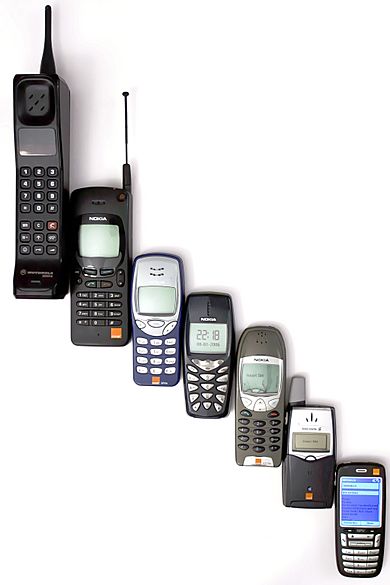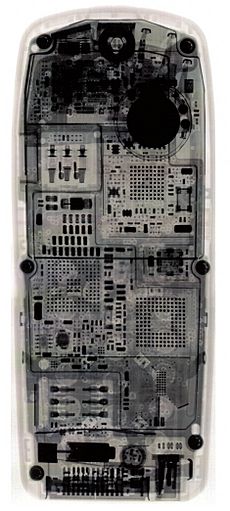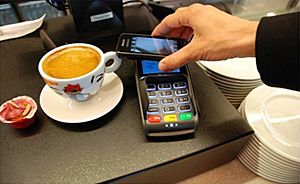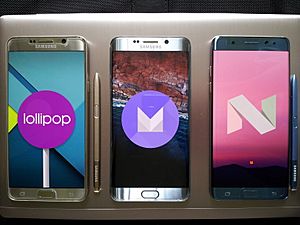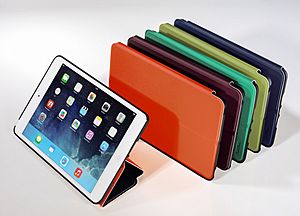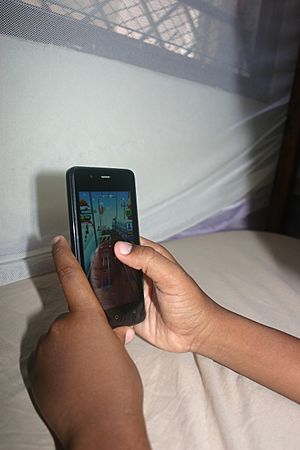Mobile phone facts for kids
A mobile phone, also called a cell phone, is a small, portable device that lets you make and receive phone calls. It connects to other phones using radio waves, even when you are moving around. Think of it like a tiny, powerful radio that can talk to other radios far away!
Modern cell phones use a special system called a cellular network. This is why they are often called "cell phones." Besides making calls, today's digital mobile phones can do many other cool things. They let you send text messages, share pictures and videos (MMS), send emails, browse the Internet, and even play games. Some also have a camera built in.
Simple mobile phones that mostly just make calls and send texts are called feature phones. But most phones today are smartphones, which are like tiny computers that fit in your pocket.
Contents
History of Mobile Phones
In the 1950s to 1970s, mobile phones were very big and heavy. Many were even built right into cars! But as technology got better in the late 1900s, phones became much smaller and easier to carry.
The very first call using a mobile phone was made by Dr. Martin Cooper from Motorola in 1973. However, his phone didn't use the same kind of cellular network we have today.
The first real mobile phone networks started in Japan in the late 1970s. Now, almost all cities and many country areas have mobile phone service.
How Mobile Phones Work
A cell phone is a clever mix of different technologies, mainly a telephone, a radio, and a computer. Most also have a digital camera inside.
Cell phones work a bit like two-way radios. They send and receive invisible microwaves through the air. These waves travel between your phone and tall towers called "base stations" using antennas. This is how they communicate without wires!
Early cell phones used older "analog" networks, but these are rare now. Most modern phones use "digital" networks.
The first digital networks were called "second generation" or 2G. The most common 2G network is GSM (Global System for Mobile communication), used a lot in Europe and Asia. In North America, CDMA (Code-Division Multiple Access) networks were more common. Today, 3G networks are widely used, and many places now have even faster 4G networks.
The radio waves that mobile phones use are split into different frequencies. Think of frequencies like different channels on a radio. They are measured in Hz. Lower frequencies can send signals farther, while higher frequencies give clearer connections. Common frequencies around the world are 850, 900, 1800, and 1900 MHz.
Some advanced phones can work on two, three, or even all four of these frequencies. These are called 'world' phones because you can use them almost anywhere!
Different Shapes of Phones
Mobile phones come in many different shapes:
- A flip phone opens up, like a small book.
- A bar phone is shaped like a candy bar, with the keys and screen on one flat side.
- A slate phone has almost no buttons and uses a touchscreen for everything. Most smartphones are slate phones.
- A slider phone has parts that slide on rails. It might slide up to show number keys or a mini keyboard.
- A swivel phone has a screen that spins around on a pivot.
Connecting to the Network
When you turn on your mobile phone, its radio receiver looks for a nearby mobile phone network base station. Then, your phone sends a request to connect. Computers at the base station check if your phone is allowed to use the network.
Each base station covers an area called a "cell." Your phone can move between different cells, but it only talks to one cell at a time. This is why mobile communication is also called "cellular communication."
Once your phone is connected to a cell, you can make calls. Because the network knows which cell your phone is in, it can also send incoming calls to your phone. Sometimes, if you go underground or into a building with thick walls, the connection to the cell can be lost. When this happens, your phone can't make or receive calls until it connects again.
Networks and How You Pay
The "network" is the company that provides your phone service. In most places, you can choose from a few different mobile networks. People often pick a network based on how well it works in their area or how much it costs.
There are two main ways to pay for mobile phone calls:
- Contract: With a contract, you pay the network a set amount of money every month. This usually gives you a lot of call time and data. Even if you don't use your phone much, you still pay the same monthly fee.
- Pay as you use: If you pay as you use, you buy a certain amount of call time or data credit. You use this credit when you make calls or go online. Once the credit runs out, you need to buy more to keep using your phone. This can be cheaper if you don't use your phone very often.
Many mobile phones, especially those using GSM technology, need a small chip called a Subscriber Identity Module (SIM card) to work. The SIM card holds important information like your phone number and payment details. You need it to make or receive calls. Sometimes you can change your network by putting a different SIM card into your phone. However, some companies "lock" their phones so you can only use their SIM card.
Other phones, mainly CDMA phones used in the United States, work differently. They have a special radio inside that only makes calls when the phone is "activated" by the network. When you buy a contract, the network gives you a code to activate your phone. It's usually impossible to switch to a different network's code on these types of phones.
Smartphones: Mini Computers
Most new mobile phones made since the 2000s are smartphones. These phones are basically small computers that you can carry in your pocket. Besides making calls, they can be used for email, browsing the internet, playing music and games, and many other things that computers can do.
Most smartphones use a common mobile operating system. This is like the main software that runs the phone. It allows developers to create mobile apps that work on many different phones without needing to change the code for each one. Famous examples of smartphones include Apple's iPhone (which uses iOS software) and Samsung's Galaxy series, which uses the Android platform made by Google.
Mobile Phone Cases
Cases are popular accessories that attach to or hold a smartphone to protect it. The size of a case is usually based on the size of the phone's screen (for example, a 5-inch display).
Here are some different types of cases:
- Pouches and sleeves are like bags for your phone.
- Holsters let you clip your phone to your belt.
- Shells are hard covers that snap onto the back of your phone.
- Skins are thin stickers that cover your phone.
- Bumpers protect just the edges of your phone.
- Flip cases and wallets cover the front and back, sometimes with card slots.
- Leather cases are made from leather.
- Screen protection and body films are clear layers that stick to your phone to prevent scratches.
- Drop and shock protection cases are extra tough to protect against falls.
Holsters are often used for phones that already have some rubber padding or are made of plastic without sharp corners. Heavy-duty cases are designed to give the best protection from drops and scratches.
Cell Phones in School
Most schools let students bring cell phones, especially so they can contact their parents or guardians if needed. However, students usually have to turn them off during class. This is because phones can distract kids from learning and interrupt lessons.
Related Pages
Images for kids
-
Martin Cooper making the first public mobile phone call in 1973.
-
The Motorola DynaTAC 8000X, the first mobile phone sold to the public in 1983.
-
Common mobile phone SIM cards.
See also
 In Spanish: Teléfono móvil para niños
In Spanish: Teléfono móvil para niños


